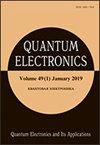双通道爆炸泵浦光解碘激光器与SBS反射镜的相结合
IF 0.9
4区 工程技术
Q3 Engineering
引用次数: 0
摘要
研究了具有爆炸抽运主振和SBS反射镜的双通道双通道碘爆炸抽运光解激光器(EPPL)。辐射源由直径为6mm的孔径确定,MO的辐射通过该孔径进入湍流表面空气路径,辐射源位于距离放大器单元输入2.5 km处。采用带有微透镜相形光栅的SBS反射镜来补偿放大器和路径的光学不均匀性,并匹配EPPL通道中的相位。通过实验和数值分析,研究了EPPL输出辐射的能量和空间特性。输出的EPPL辐射在MO孔径平面内的能量密度分布与实验结果吻合较好,这是两个通道之间的干涉模式。孔径平面上的最大能量密度是单通道EPPL的4倍以上。本文章由计算机程序翻译,如有差异,请以英文原文为准。
Phase combining of radiation from a two-channel explosively pumped photodissociation iodine laser with an SBS mirror
A two-channel double-pass iodine explosively pumped photodissociation laser (EPPL) with an explosively pumped master oscillator (MO) and an SBS mirror is studied. The radiation source, determined by an aperture 6 mm in diameter, through which the radiation from MO enters the turbulent surface air path, is located at a distance of 2.5 km from the amplifier unit input. An SBS mirror with a kinoform raster of microlenses is used to compensate for the amplifier and path optical inhomogeneities and to match the phases in the EPPL channels. The energy and spatial characteristics of the EPPL output radiation are studied experimentally and numerically. Good agreement is obtained between the experimental and calculated distribution of the energy density of the output EPPL radiation in the plane of the MO aperture, which is a pattern of interference between the two channels. The maximum energy density in the aperture plane is by more than 4 times greater than in the case of a single-channel EPPL.
求助全文
通过发布文献求助,成功后即可免费获取论文全文。
去求助
来源期刊

Quantum Electronics
工程技术-工程:电子与电气
CiteScore
3.00
自引率
11.10%
发文量
95
审稿时长
3-6 weeks
期刊介绍:
Quantum Electronics covers the following principal headings
Letters
Lasers
Active Media
Interaction of Laser Radiation with Matter
Laser Plasma
Nonlinear Optical Phenomena
Nanotechnologies
Quantum Electronic Devices
Optical Processing of Information
Fiber and Integrated Optics
Laser Applications in Technology and Metrology, Biology and Medicine.
 求助内容:
求助内容: 应助结果提醒方式:
应助结果提醒方式:


